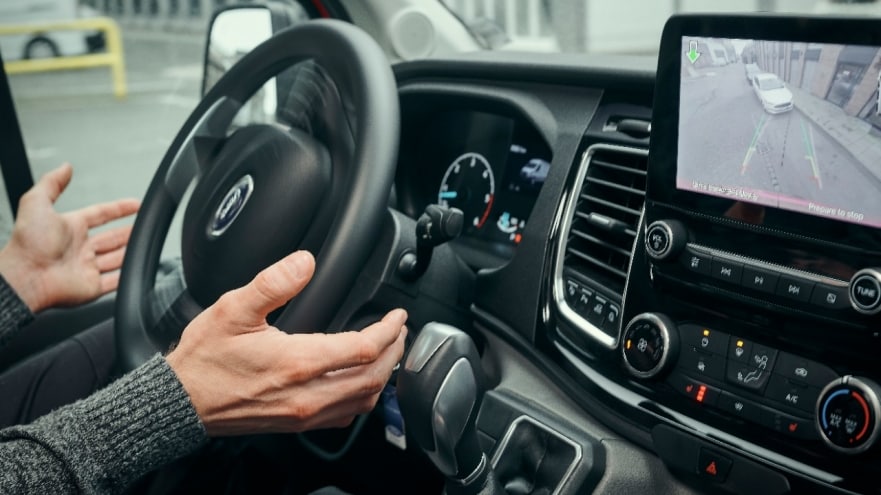Parking a van that is more than one metre longer than a Mondeo wagon in crowded streets or loading bays can be the stuff of nightmares. And even a low-speed bump can cost a business money in lost working time and repairs, with the potential for increased insurance costs, particularly if a third party is involved.
The new Ford Transit takes the stress out of parking with advanced technologies that can also help avoid expensive parking prangs.
Ford’s Active Park Assist technology helps Transit drivers to find a suitably-sized parking space and then automatically steers the vehicle into the spot while the driver controls the throttle and brake. The system helps make light work of parking in a side-by-side space such as a loading bay, or nose-to-tail in a roadside space just 0.8 metres longer than the vehicle.
Additional Transit technologies including Park-Out Assist, Cross Traffic Alert, Side Sensing System* and front and rear wide-view cameras lend operators a hand when pulling out from a space or manoeuvring in crowded urban environments.
Advanced Transit technologies*
Available on the latest Transit and Transit Custom models introduced during 2019, Active Park Assist technology functions using 12 ultrasonic sensors around the vehicle. The system can park the van even in scenarios when no roadside kerb is present by lining up with another parked vehicle and works when parking on inclines.
Active Park Assist includes Park-Out Assist, which automatically steers the vehicle out of a parking space while the driver controls the throttle and brake.
Ford’s Cross Traffic Alert warns drivers reversing out of a parking space of vehicles and bicycles that may soon be crossing behind them.
In addition, a Side Sensing System delivers audible and visual warnings of nearby obstacles to help drivers manoeuvre at low speed.
Transit’s front wide-view camera and rear wide-view camera display to the driver wide-angle views that make it easier to spot approaching vehicles, pedestrians or cyclists at a blind junction or when exiting a parking space or driveway.
The rear-view camera is high-mounted above the cargo doors to offer better visibility when reversing, in particular with the rear doors open.
Helping customers’ businesses thrive
The new generation of electrified and connected Transit and Transit Custom vans launched in 2019 and was developed to help businesses thrive in a modern operating environment.
The new Ford Transit 2-tonne van can carry more, uses less fuel and is easier to drive and operate than ever, supported by fuel-efficient EcoBlue diesel powertrains including segment-first EcoBlue Hybrid 48-volt technology and innovative driver assistance features.
An enhanced Ford Transit Custom 1-tonne van also delivers Ford’s latest EcoBlue and new EcoBlue Hybrid powertrains, alongside available technologies including the FordPass Connect on-board modem that can help operators maximise vehicle efficiency and utilisation.
The electrified Transit Custom Hybrid range – including the Transit Custom Plug-In Hybrid and EcoBlue Hybrid – is International Van of the Year 2020.
Last year was Ford’s best for commercial vehicle sales in 25 years – and Ford’s fifth year as Europe’s No.1 commercial vehicle brand.**
Read more about the new Ford Transit and Transit Custom.
“Frequent stops in busy city streets are the norm for many van drivers during the working day, and that can be a challenge in such a large vehicle where visibility can be limited. Ford technologies like Active Park Assist help drivers and operators put their energy into their best work, and spend less time stressing about parking.” Ian Porter, Transit chief programme engineer
# # #
*Feature may be offered at additional cost. Driver-assist features are supplemental to and do not replace the driver’s attention, judgement and need to control the vehicle.
**Based on the latest year-to-date data available through December 2019. Ford of Europe reports sales for its 20 European traditional markets where it is represented through National Sales Companies: Austria, Belgium, Britain, Czech Republic, Denmark, Finland, France, Germany, Greece, Hungary, Ireland, Italy, Netherlands, Norway, Poland, Portugal, Spain, Romania, Sweden and Switzerland.
- Transit EcoBlue Hybrid CO2 emissions from 143 g/km and fuel efficiency from 5.5 l/100 km NEDC
- Transit Custom EcoBlue Hybrid CO2 emissions from 137g/km, fuel efficiency from 5.3 l/100 km NEDC
- Transit Custom Plug-In Hybrid CO2 emissions 60 g/km, fuel efficiency 2.7 l/100 km NEDC
The declared fuel/energy consumptions, CO2-emissions and electric range are determined according to the technical requirements and specifications of the European Regulations (EC) 715/2007 and (EU) 2017/1151 as last amended. Light Duty Vehicle type-approved using the World Harmonised Light Vehicle Test Procedure (WLTP) will have fuel/energy consumption and CO2-emission information for New European Drive Cycle (NEDC) and WLTP. WLTP will fully replace the NEDC latest by the end of the year 2020. The applied standard test procedures enable comparison between different vehicle types and different manufacturers. During NEDC phase-out, WLTP fuel consumption and CO2 emissions are being correlated back to NEDC. There will be some variance to the previous fuel economy and emissions as some elements of the tests have altered, so the same car might have different fuel consumption and CO2 emissions.

